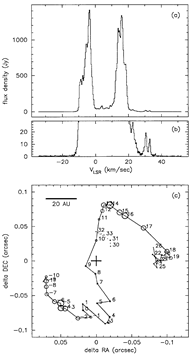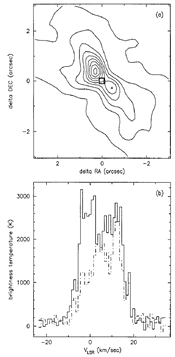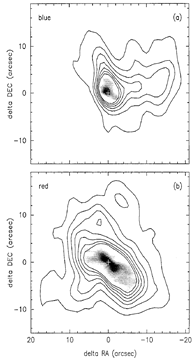|
Orion KL -- a giant molecular
cloud complex
- (Wright et al., 1995ApJ...455L.185W)
They mapped the SiO v=0 and 1 J=2-1 masers in Orion KL using BIMA. The SiO v=1 masers appeared in a ring of a diameter of 80 AU, the high resolution map of the v=0 masers showed a flared disk, while the low resolution map delineated the bipolar outflow perpendicular to the disk.
(figs: left -- SiO v=1 J=2-1 line profile and high resolutiion map showing a ring structure; middle -- SiO v=0 J=2-1 map and detailed line profile; right -- low resolution v=0 sio maser, with high resolution components as gray scale map in the center.)
  
- (Wright et al., 1996ApJ...469..216W)
They mapped Orion KL region at 1"-6" resolution with BIMA. 28 lines of 16 molecular species were mapped. They discussed the two major components of the gas and compared them with infrared observations. Hot cores, ridges, outflows are identified. In the outflows, SiO was found to fill the expanding shells of the outflow, SO and SO2 are in an expanding shell surrounding the SiO bubbles, while HCN and HC3N may trace material ablated from the dense clumps at the perifery of the cavity. They prefer grain destruction as the source of the SiO formation in the outflow cavity. High abundance of HDO, DCN, and other deuterated species in the hot cores indicate evaporation of the icy grain mantles; the prominant CH3OH in the ridge may indicate selective evaporation of this species from gain mantles at a lower temperature than H2O.
- (Schilke et al., 1997ApJS..108..301S)
Facts: They present a single dish line survey for massive star forming region Orion KL in the 325-360 GHz using CSO telescope.
Results: They detected 717 lines with 60 of which are unidentified. The lines are identified for 34 species and various isotopomers. The two strongest line emitters are SO2 and SO, whilst CO is only the third strong emitter. Many lines belong to heavy organic rotors, but these weeds line contribute little to the integrated line fluxes. CH3OH are also very prominent in this source. The first detection of HCN line in v2=2 state (above 2000K) is reported.
|
|
![]()

